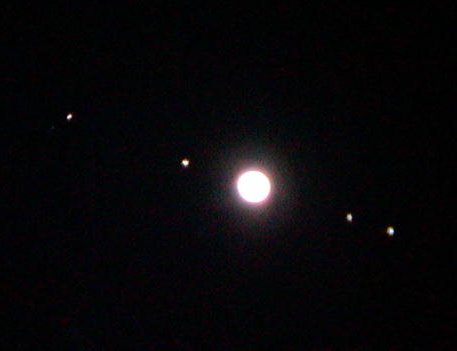
Physorg has provided a sky watcher's guide for June.
If you have a telescope or even binoculars of appropriate strength, there are a few astonishing sights waiting for you in the night sky... incidentally, all discovered by Galileo Galilei in the 1600s. Be sure to check out:
1. The moons of Jupiter - called the Galilean satellites (after their discoverer), the four big moons of Jupiter are visible with a telescope or some binoculars. It will look something like the picture to the right.
2. The rings of Saturn - may be hard to see with binoculars, but most telescopes (20x magnification or better) will be able to resolve the rings. (A reader points out that the rings are very difficult to see at present, since they are currently titled only 1.7° from our perspective).
3. The mountains on the Moon - look around the edges if it's a full moon, since that's where the mountains are rising perpendicular to your point of view, and where the Sun casts the longest shadows.
Of course, these images won't be as brilliant as the photographs from Hubble or robotic missions to the planets. But there's something awesome about receiving the light from these objects in real time. There's nothing between you and the planets except the vast emptiness of space. And if your telescope is set up on a tripod, you'll see that the Moon and the planets will move out of your field of view very quickly, as a result of the Earth's rotation.
I love everything about this blog,I'm facinated by the stars, outer space, I'm totally in to it.
ReplyDeleteThank you for this post.
Nice blog!
ReplyDeleteSaturn's rings may be a bit difficult to see right now as they are only open a couple of degrees. By the end of the year it should be better for they open to about 10 degrees.
The best time to see features on the Moon is as it is waxing or waning; the terminator casts shadows that enhance height and depth.
You're absolutely right! Thanks for keeping me straight.
ReplyDelete